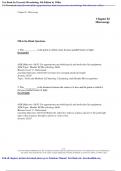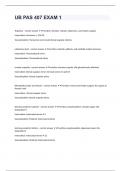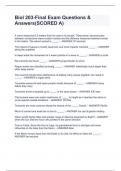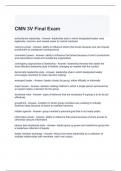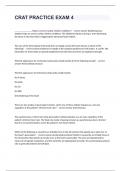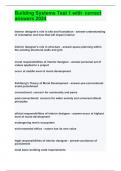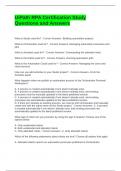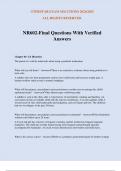Major topics Low stakes topics TJNOTES
GCSE Chemistry Notes
PAPER II
Calculating Rates of Reaction
• To calculate the mean rate of reaction, we can either do:
𝑎𝑚𝑜𝑢𝑛𝑡 𝑜𝑓 𝑟𝑒𝑎𝑐𝑡𝑎𝑛𝑡 𝑢𝑠𝑒𝑑 𝑎𝑚𝑜𝑢𝑛𝑡 𝑜𝑓 𝑝𝑟𝑜𝑑𝑢𝑐𝑡 𝑓𝑜𝑟𝑚𝑒𝑑
• or
𝑡𝑖𝑚𝑒 𝑡𝑎𝑘𝑒𝑛 𝑡𝑖𝑚𝑒 𝑡𝑎𝑘𝑒𝑛
• Rate of reaction can be measured in g/s, cm3/s, or mol/s
• To calculate the rate of reaction at a specific point on a curve, we draw a tangent
and calculate the gradient
• To calculate the mean rate of reaction in certain period of time, use the equation
above
Factors affecting rate of reaction
• Collision theory states that chemical reactions can only take place when reacting
particles collide with each other and with sufficient energy
• The rate of a chemical reaction is determined by the frequency of successful
collisions
Effect of Concentration and Pressure
• When we carry out any reaction, the product-time graph always looks like
this:
• We can explain this using collision theory
• Reactions are rapid initially (steep gradient) because we have a large number of
reactant molecules (a high concentration)
• This means that we have a large number of successful collisions per second
because they are very close together
,Major topics Low stakes topics TJNOTES
• As reaction progresses, the reaction slows down because number of reactant
molecules is running out so the frequency of successful collisions is decreasing,
decreasing the rate of reaction
• The graph then levels off because reactions stop due to all of reactants running
out so no more collisions take place
• We can represent the effect of concentration and pressure (same concept is one
is particles within liquids and the other is gaseous particles) in this diagram:
• Both containers have the same volume of gas/liquid but the one on the right has
more particles – hence the concentration/pressure is higher
• On the right, the particles are very close together due to the high
pressure/concentration – because of this, there will be more frequent successful
collisions between particles
• Therefore, as we increase concentration/pressure, the rate of reaction increases
• In fact, the rate is proportional to the concentration/pressure – if we double
concentration or pressure, we double the rate of reaction
• The rate of reaction is faster in the higher concentration (explained above) as we
can see that the gradient is greater (line is steeper)
• There is a greater quantity of product formed as well because we had a greater
quantity of reactants at the beginning
,Major topics Low stakes topics TJNOTES
Effect of Surface Area
• As we increase the surface area of a reactant solid, the rate of reaction increases
• To explain this, we need a diagram:
• When we have a solid reactant, only the particles on the surface can react with
other reacting particles (shown in orange)
• Reacting particles like those in a liquid or gas, cannot collide with particles that
are not exposed to the surface
• If we split the solid into smaller pieces (in other words, we increase the surface
area to volume ratio):
• So, as we increased the surface area, more particles became exposed to
collisions, meaning that more particles can collide and react per second – in
other words the frequency of successful collisions has increased
• Smaller sized blocks of solid reactant have a greater surface area to volume ratio
than larger blocks, which is why, when we split it up, the rate of reaction
increased because the surface area in comparison to its volume increased
• This helps to explain why powdered reactants show a higher rate of reaction
than granules because they are smaller and finer, so higher SA:V
,Major topics Low stakes topics TJNOTES
To investigate the effect of surface area on rate of reaction, we can use the
following apparatus:
• The CaCO3 in the marble chips reacts with the hydrochloric acid to produce
carbon dioxide gas
• We can use the rate of production of CO2 to measure the rate of reaction
• If we compare using one large marble chip with several smaller marble chips
(with the same mass), we will see that the smaller marble chips of the same mass
will have a higher rate of reaction because they have a higher surface area to
volume ratio
• The bubbles can be quite rapid so, instead of using a measuring cylinder, we can
get more accurate results by using a gas syringe (note: accuracy and validity are
two different things, if we wanted to assess the validity, we would say use same
mass of marble chip, same volume/conc of HCl, etc)
We can use another set up to test the surface area:
• Here, we can measure the mass of carbon dioxide lost from the flask (mass
decrease) and also use that to determine the rate of reaction
• The cotton wool allows carbon dioxide to pass through it but does not allow acid
to splash out of the flask and affect the mass and lead to anomalies
,Major topics Low stakes topics TJNOTES
Effect of Temperature on rate
• Particles must collide with sufficient energy
• This sufficient energy is the activation energy of the reaction
• Activation energy is the minimum amount of energy required for reactant
particles to collide and react (collide successfully)
• Activation energy is like a barrier
• When we increase the temperature, we increase the energy of the particles
• This means that more particles will have enough energy to meet the activation
energy “barrier” – this increases the frequency of successful collisions because
more particles have the ability to collide each second
• When we increase energy, we are increasing the kinetic energy of the particles,
meaning they travel faster and collide with other particles much more
frequently, again this increases the rate of reaction because there is a higher
frequency of successful collisions between reacting particles
Therefore, to summarise, increasing the temperature increases the rate of
reaction by :
(1) increasing frequency
(2) increasing energy of collisions so more are classed as “successful”
Effect of Catalysts
• Catalysts increase the rate of reaction without being used up in the reaction (so
are not included in chemical equations)
• They are extremely important because they allow us to carry reactions out
quickly without needing to increase the temperature, thus saving money
• Activation energy is the minimum amount of energy required for particles to
collide and react successfully:
,Major topics Low stakes topics TJNOTES
Catalysts increase the rate of reaction by providing an alternative reaction
pathway that has a lower activation energy :
How does lowering the activation energy increase the rate?
• As the catalyst lowers the activation energy, that means more particles “qualify”
to meet the activation energy barrier – this means more collisions are classed as
“successful” per second. Because more collisions are successful per second, the
rate of reaction increases
• Imagine it being like an exam with a grade boundary. Instead of getting a higher
percentage in order to get a 9 (which is what we do with temperature), we are
lowering the grade boundary (the activation energy) so that more people get a 9
(more particles collide successfully)
, Major topics Low stakes topics TJNOTES
Required Practical 5: Rates of Reaction
Aim 1: To investigate the effect of concentration on the rate of reaction by a method
involving a change in turbidity
Hypothesis:
Note: a hypothesis is a proposal that could explain a fact or an observation – this
hypothesis must be testable
Apparatus:
Theory:
• When we react sodium thiosulfate with hydrochloric acid, we produce a solid
sulfur precipitate that makes the solution go opaque and cloudy
• This cloudiness is called turbidity – and we can use it to see how long a reaction
takes to finish
Method:
1) Use a measuring cylinder to put 10cm3 of sodium thiosulfate solution into a
conical flask
2) Place the conical flask onto a printed black cross
3) Add 10cm3 of hydrochloric acid, swirl the solution and start a stopwatch
immediately
4) Stop the clock once we can no longer see the cross through the solution
5) Repeat the experiment using different concentrations of sodium thiosulfate (it is
best to start with the highest concentration because that is the quickest)
6) Repeat the whole experiment and calculate mean values for each concentration
of sodium thiosulfate solution, ensuring it is repeatable (and comparing with
other groups to test reproducibility)
GCSE Chemistry Notes
PAPER II
Calculating Rates of Reaction
• To calculate the mean rate of reaction, we can either do:
𝑎𝑚𝑜𝑢𝑛𝑡 𝑜𝑓 𝑟𝑒𝑎𝑐𝑡𝑎𝑛𝑡 𝑢𝑠𝑒𝑑 𝑎𝑚𝑜𝑢𝑛𝑡 𝑜𝑓 𝑝𝑟𝑜𝑑𝑢𝑐𝑡 𝑓𝑜𝑟𝑚𝑒𝑑
• or
𝑡𝑖𝑚𝑒 𝑡𝑎𝑘𝑒𝑛 𝑡𝑖𝑚𝑒 𝑡𝑎𝑘𝑒𝑛
• Rate of reaction can be measured in g/s, cm3/s, or mol/s
• To calculate the rate of reaction at a specific point on a curve, we draw a tangent
and calculate the gradient
• To calculate the mean rate of reaction in certain period of time, use the equation
above
Factors affecting rate of reaction
• Collision theory states that chemical reactions can only take place when reacting
particles collide with each other and with sufficient energy
• The rate of a chemical reaction is determined by the frequency of successful
collisions
Effect of Concentration and Pressure
• When we carry out any reaction, the product-time graph always looks like
this:
• We can explain this using collision theory
• Reactions are rapid initially (steep gradient) because we have a large number of
reactant molecules (a high concentration)
• This means that we have a large number of successful collisions per second
because they are very close together
,Major topics Low stakes topics TJNOTES
• As reaction progresses, the reaction slows down because number of reactant
molecules is running out so the frequency of successful collisions is decreasing,
decreasing the rate of reaction
• The graph then levels off because reactions stop due to all of reactants running
out so no more collisions take place
• We can represent the effect of concentration and pressure (same concept is one
is particles within liquids and the other is gaseous particles) in this diagram:
• Both containers have the same volume of gas/liquid but the one on the right has
more particles – hence the concentration/pressure is higher
• On the right, the particles are very close together due to the high
pressure/concentration – because of this, there will be more frequent successful
collisions between particles
• Therefore, as we increase concentration/pressure, the rate of reaction increases
• In fact, the rate is proportional to the concentration/pressure – if we double
concentration or pressure, we double the rate of reaction
• The rate of reaction is faster in the higher concentration (explained above) as we
can see that the gradient is greater (line is steeper)
• There is a greater quantity of product formed as well because we had a greater
quantity of reactants at the beginning
,Major topics Low stakes topics TJNOTES
Effect of Surface Area
• As we increase the surface area of a reactant solid, the rate of reaction increases
• To explain this, we need a diagram:
• When we have a solid reactant, only the particles on the surface can react with
other reacting particles (shown in orange)
• Reacting particles like those in a liquid or gas, cannot collide with particles that
are not exposed to the surface
• If we split the solid into smaller pieces (in other words, we increase the surface
area to volume ratio):
• So, as we increased the surface area, more particles became exposed to
collisions, meaning that more particles can collide and react per second – in
other words the frequency of successful collisions has increased
• Smaller sized blocks of solid reactant have a greater surface area to volume ratio
than larger blocks, which is why, when we split it up, the rate of reaction
increased because the surface area in comparison to its volume increased
• This helps to explain why powdered reactants show a higher rate of reaction
than granules because they are smaller and finer, so higher SA:V
,Major topics Low stakes topics TJNOTES
To investigate the effect of surface area on rate of reaction, we can use the
following apparatus:
• The CaCO3 in the marble chips reacts with the hydrochloric acid to produce
carbon dioxide gas
• We can use the rate of production of CO2 to measure the rate of reaction
• If we compare using one large marble chip with several smaller marble chips
(with the same mass), we will see that the smaller marble chips of the same mass
will have a higher rate of reaction because they have a higher surface area to
volume ratio
• The bubbles can be quite rapid so, instead of using a measuring cylinder, we can
get more accurate results by using a gas syringe (note: accuracy and validity are
two different things, if we wanted to assess the validity, we would say use same
mass of marble chip, same volume/conc of HCl, etc)
We can use another set up to test the surface area:
• Here, we can measure the mass of carbon dioxide lost from the flask (mass
decrease) and also use that to determine the rate of reaction
• The cotton wool allows carbon dioxide to pass through it but does not allow acid
to splash out of the flask and affect the mass and lead to anomalies
,Major topics Low stakes topics TJNOTES
Effect of Temperature on rate
• Particles must collide with sufficient energy
• This sufficient energy is the activation energy of the reaction
• Activation energy is the minimum amount of energy required for reactant
particles to collide and react (collide successfully)
• Activation energy is like a barrier
• When we increase the temperature, we increase the energy of the particles
• This means that more particles will have enough energy to meet the activation
energy “barrier” – this increases the frequency of successful collisions because
more particles have the ability to collide each second
• When we increase energy, we are increasing the kinetic energy of the particles,
meaning they travel faster and collide with other particles much more
frequently, again this increases the rate of reaction because there is a higher
frequency of successful collisions between reacting particles
Therefore, to summarise, increasing the temperature increases the rate of
reaction by :
(1) increasing frequency
(2) increasing energy of collisions so more are classed as “successful”
Effect of Catalysts
• Catalysts increase the rate of reaction without being used up in the reaction (so
are not included in chemical equations)
• They are extremely important because they allow us to carry reactions out
quickly without needing to increase the temperature, thus saving money
• Activation energy is the minimum amount of energy required for particles to
collide and react successfully:
,Major topics Low stakes topics TJNOTES
Catalysts increase the rate of reaction by providing an alternative reaction
pathway that has a lower activation energy :
How does lowering the activation energy increase the rate?
• As the catalyst lowers the activation energy, that means more particles “qualify”
to meet the activation energy barrier – this means more collisions are classed as
“successful” per second. Because more collisions are successful per second, the
rate of reaction increases
• Imagine it being like an exam with a grade boundary. Instead of getting a higher
percentage in order to get a 9 (which is what we do with temperature), we are
lowering the grade boundary (the activation energy) so that more people get a 9
(more particles collide successfully)
, Major topics Low stakes topics TJNOTES
Required Practical 5: Rates of Reaction
Aim 1: To investigate the effect of concentration on the rate of reaction by a method
involving a change in turbidity
Hypothesis:
Note: a hypothesis is a proposal that could explain a fact or an observation – this
hypothesis must be testable
Apparatus:
Theory:
• When we react sodium thiosulfate with hydrochloric acid, we produce a solid
sulfur precipitate that makes the solution go opaque and cloudy
• This cloudiness is called turbidity – and we can use it to see how long a reaction
takes to finish
Method:
1) Use a measuring cylinder to put 10cm3 of sodium thiosulfate solution into a
conical flask
2) Place the conical flask onto a printed black cross
3) Add 10cm3 of hydrochloric acid, swirl the solution and start a stopwatch
immediately
4) Stop the clock once we can no longer see the cross through the solution
5) Repeat the experiment using different concentrations of sodium thiosulfate (it is
best to start with the highest concentration because that is the quickest)
6) Repeat the whole experiment and calculate mean values for each concentration
of sodium thiosulfate solution, ensuring it is repeatable (and comparing with
other groups to test reproducibility)

